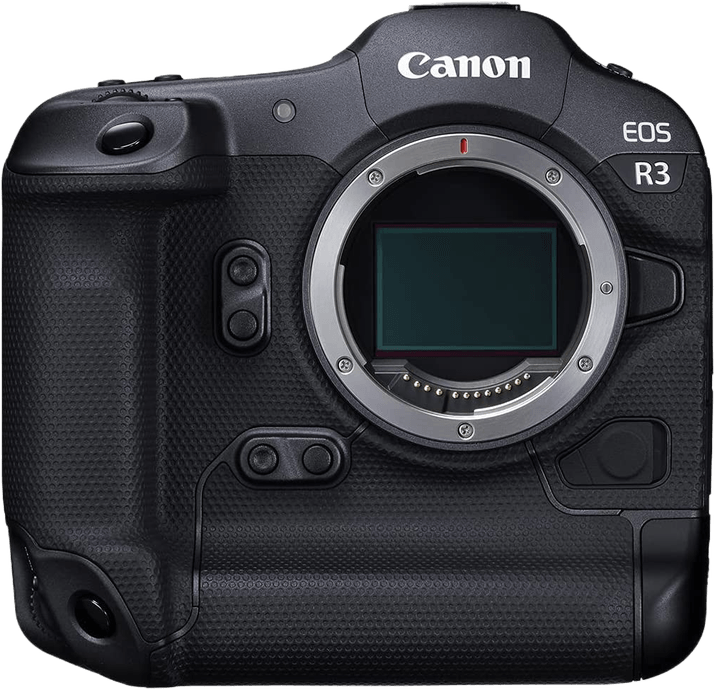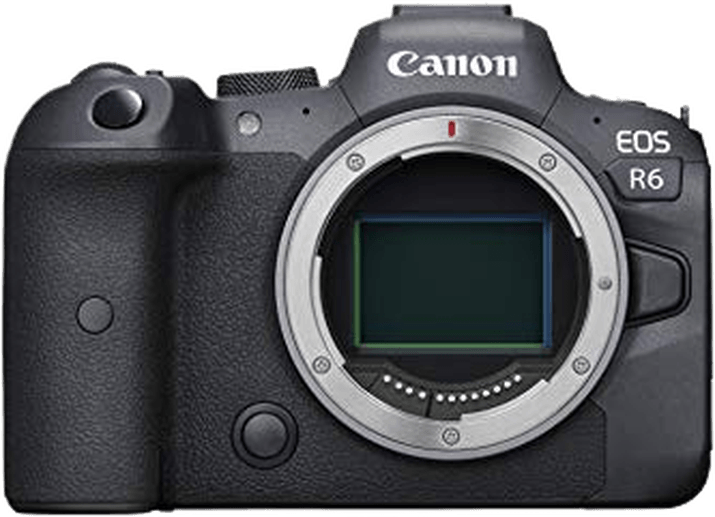Canon EOS R3 vs EOS R6 Comparison
Canon EOS R3

Canon EOS R6

The Canon EOS R3 takes the lead with a score of 84/100, while the Canon EOS R6 trails close behind with a score of 80/100. Both cameras share similarities, being mirrorless and announced within a year of each other. The R3, however, boasts a higher launch price of $5999 compared to the R6’s $2499.
The R3’s advantages include a larger size (150 x 143 x 87mm) and heavier weight (1015g / 2.24lbs), which may contribute to its sturdiness and durability. On the other hand, the R6’s smaller size (138 x 98 x 88mm) and lighter weight (680g / 1.50lbs) make it a more portable and convenient option for photographers on the go.
Despite the R6’s lower score, its more affordable price and compact size make it an attractive option for those prioritizing budget and portability. However, the R3’s higher score and heftier build indicate it may be the better choice for professionals seeking top-notch performance and durability.
Canon EOS R3 vs EOS R6 Overview and Optics
The Canon EOS R3 outperforms the Canon EOS R6 in optics, scoring 84/100 compared to the R6’s 79/100. Both cameras share several specifications, including a CMOS sensor, Digic X processor, full-frame sensor size, Canon RF lens mount, and image stabilization. Despite these similarities, there are notable differences that set the R3 ahead of the R6.
The R3 has a higher megapixel count at 24, compared to the R6’s 20.1. This difference allows the R3 to capture more detail and produce higher resolution images. Additionally, the R3 boasts a faster shooting speed of 30 frames per second (fps), while the R6 only reaches 20 fps. This faster shooting speed enables the R3 to capture fast-moving subjects more effectively, making it a better choice for action and sports photography.
Moreover, the R3 has a higher DXOMARK score for its sensor, at 96 compared to the R6’s 90. This higher score points to the R3 having a better overall image quality, dynamic range, and low-light performance.
However, the R6 is not without its advantages. Its lower score does not necessarily mean it is a poor camera, but rather it is simply not as strong as the R3 in certain aspects. The R6 still offers excellent image quality and performance, making it a suitable choice for various photography needs.
Considering the aforementioned points, the Canon EOS R3 is the better camera in terms of optics, with its higher megapixel count, faster shooting speed, and superior sensor performance. While the Canon EOS R6 is an excellent camera, it falls short in comparison to the R3 in these areas.
Canon EOS R3 vs EOS R6 Video Performance
The Canon EOS R3 outperforms the Canon EOS R6 in video capabilities, earning a video score of 96/100 compared to the R6’s 91/100. Both cameras have several shared features, including a maximum video frame rate of 120fps and built-in time-lapse functionality. Despite these similarities, the R3 surpasses the R6 in specific video specifications.
The R3’s superior video quality is evident in its maximum video resolution of 6K and dimensions of 6000 x 3164, which are higher than the R6’s 4K resolution and 3840 x 2160 dimensions. This difference means the R3 can capture more detailed and sharper footage, making it the better choice for professional videographers and content creators.
While the R6 falls short in comparison to the R3, it still boasts impressive video capabilities. With a 4K resolution and 120fps frame rate, the R6 is more than suitable for high-quality video production and can meet the needs of many users. Additionally, the R6’s lower price point may appeal to those who require solid video performance but are not seeking the absolute best in resolution and detail.
Considering the specifications and performance of both cameras, the Canon EOS R3 is the clear winner in terms of video capabilities. Its 6K resolution and larger dimensions offer a significant advantage over the R6, making it the ideal choice for professional videographers. However, the Canon EOS R6 remains a strong contender for those who require a high-quality camera with 4K resolution at a more affordable price.
Canon EOS R3 vs EOS R6 Features and Benefits
The Canon EOS R3 wins the feature comparison with a score of 87/100, while the Canon EOS R6 scores 85/100. Both cameras share several specifications, such as touchscreen capability, flip screen, WIFI, and Bluetooth connectivity. However, there are differences that make the EOS R3 a better choice in terms of features.
The EOS R3 has a larger screen size of 3.2 inches compared to the EOS R6’s 3 inches. This difference allows for easier image framing and review on the EOS R3. Additionally, the EOS R3’s screen resolution is significantly higher at 4,150,000 dots, compared to the EOS R6’s 1,620,000 dots. This higher resolution provides a clearer and more detailed display on the EOS R3.
Another advantage of the EOS R3 is its GPS feature, which the EOS R6 lacks. This enables photographers to geotag their images, making it easier to track and organize photos based on location.
On the other hand, the EOS R6 may still be a suitable choice for some users. Its lower feature score does not necessarily mean it is a bad camera. It retains many of the same features as the EOS R3, such as the touchscreen, flip screen, WIFI, and Bluetooth connectivity. For users who do not require a larger screen, higher screen resolution, or GPS functionality, the EOS R6 can be a more cost-effective option.
In comparing the Canon EOS R3 and EOS R6, the EOS R3 proves to be the better camera in terms of features, with a larger screen, higher screen resolution, and GPS capability. However, the EOS R6 remains a viable option for those who do not need these additional features and are seeking a more budget-friendly camera.
Canon EOS R3 vs EOS R6 Storage and Battery
The Canon EOS R3 outperforms the Canon EOS R6 in storage and battery with a score of 81/100, a significant 13-point lead over the R6’s score of 68/100. Both cameras share some common specifications, including two memory card slots and USB charging capabilities. However, the R3 has a notable advantage in battery life and memory card compatibility.
The EOS R3’s battery life lasts for an impressive 760 shots, while the R6 only manages 360 shots. Additionally, the R3 accepts both SD/SDHC/SDXC and CFexpress Type B memory cards, offering greater flexibility compared to the R6, which only supports SD/SDHC/SDXC cards.
The EOS R6 does not have any specific advantages in storage and battery over the R3. The R3’s longer battery life and broader memory card compatibility make it the clear winner in this category. The R6’s lower score reflects its limited capabilities in these aspects compared to the R3.
Canon EOS R3 vs EOS R6 Alternatives
Still not sure which camera is best for you? Check out some more popular camera comparisons for inspiration:
